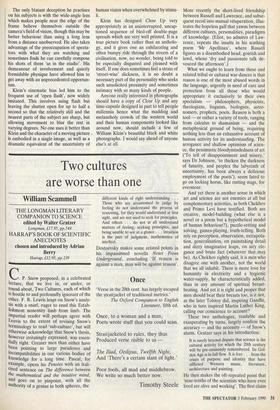From thug to discriminating omnivore
Bruce Bernard
CLOSE UP by William Klein
Thames & Hudson, £24, pp.176
William Klein has only gained general acceptance in polite photographic circles during the last few years. Brash and reckless seeming in his work, with none of the self-conscious respect for humanity that has long been sacred to devotees of 'concerned' photography, he has until re- cently been thought of as a brilliant but undoubted thug of the street photograph. Born in New York in 1928, Klein started his artistic career as a 'hard edge' painter in Paris. On returning to New York in 1954 he decided to keep a photographic diary which he made into a book. 'I'd discovered that I was able to feed my devouring hunger for faces, bodies, crowds... My plan was to stuff everything, everybody into my little chromium box', he writes in a note to one of his earliest pictures and his
life became for a while . one day painting flat enamelled surfaces in the studio; another out looting the street. Dr Jekyll and Mr Hyde'.
The gentlemanly origins of photography have manifested themselves in various disguises ever since Fox Talbot (and not always a bad thing at all). The liberal humanism of the Magnum school, and in criticism even the Marxist puritanism of the self-proclaimed intellectual John Ber- ger, and the formidable Susan Sontag owe something to the medium's beginnings in enlightened amateurism. That is perhaps why it took so long for what any day may become the 'photographic community' to reconcile itself to Klein's breaches of eti- quette, with his self-confessed 'looting' of the streets — even if his use of the term is part self-mockery and/or swagger.
In the Fifties Klein made (and designed) several sensational books of photographs, shot some highly original fashion and then started making movies instead, many of which won prizes. The best known is probably 'Qui etes-vous Polly Maggoo?' In the late Seventies his early still work began to find favour; shows were put on and features written. This stimulated him to go out on the streets again where he soon refound his touch. Although some of his early work appears self-consciously shocking, rather like animated or ja77ed-up Diane Arbus, it now seems clear that his visual voracity has never excluded consid- eration for or warmth towards his fellow human beings. He is a discriminating omni- vore, and the notes in his book as well as the pictures themselves show that he takes an intelligent interest in all the people he sees and also pleasure in often finding them sympathetic. His approach is intensely physical and conveys a visceral sense of kinship with every kind of human.
I have never seen a picture of Klein's apart from fashion with less than three figures in it and this of course excludes a very considerable dimension of human life. But there are many memorable individuals (and couples) in his line-ups and melees and one marvellous photograph which is in effect a study of a single 82-year-old member of the Academie Frangaise. He does make fine portraits in his way.
'1987: Tokyo. Sumo wrestlers about to make their entrance in the Stadium' The only blatant deception he practises on his subjects is with the wide-angle lens which makes people near the edge of the frame believe themselves outside the camera's field of vision, though this may be better behaviour than using a long lens from a distance unobserved. He also takes advantage of the preoccupation of specta- tors with what they are watching and sometimes finds he can carefully compose his shots of them 'as in the studio'. His demeanour of involvement and quietly formidable physique have allowed him to get away with an unprecedented opportun- ism.
Klein's cinematic bias led him to the frequent use of 'open flash', now widely imitated. This involves using flash but leaving the shutter open for up to half a second so that the relatively still and the nearest parts of the subject are sharp, but allowing movement to blur the rest in varying degrees. No one uses it better than Klein and the character of a moving picture is embodied in a single image, aS well as a dramatic equivalent of the uncertainty of human vision when overwhelmed by stimu- li.
Klein has designed Close Up very appropriately as an uninterrupted, uncap- tioned sequence of bled-off double-page spreads which are very well printed. It is a true picture book rather than an antholo- gy, and it gives one an exhilarating and often bumpy ride through the streets of a civilisation, now, no wonder, being told to be especially disgusted and pleased with itself. If one does sometimes feel a strain of 'street-wise' slickness, it is no doubt a necessary part of the personality who seeks such unsolicited proximity and sometimes intimacy with so many kinds of people.
Anyone really interested in photographs should have a copy of Close Up and any time-capsule designed in part to tell people millennia hence what the madding and melancholy crowds of the western world and their human components looked like around now, should include a few of William Klein's beautiful black and white photographs. I would say ahead of anyone else's at all.



















































 Previous page
Previous page